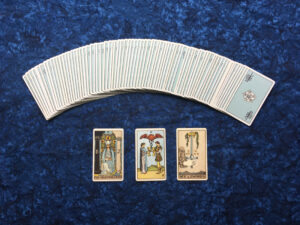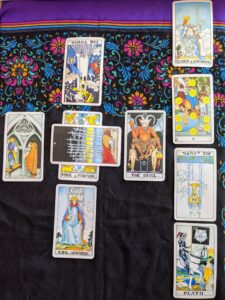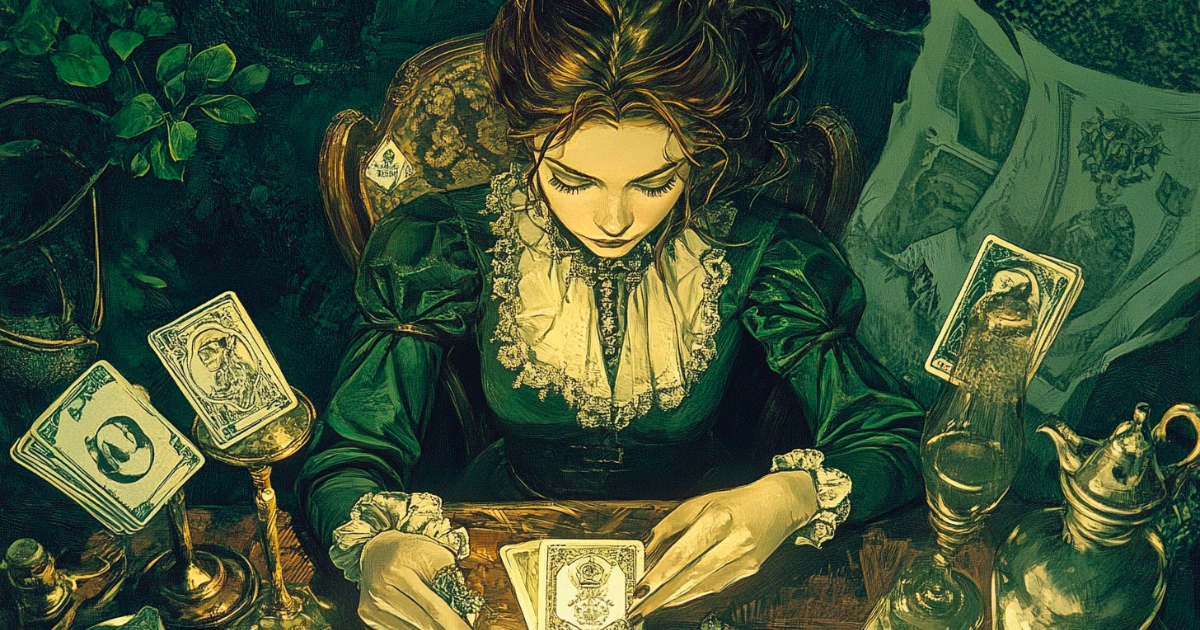Tarot reading is a mystical divination art that uses 78 cards imbued with ancient wisdom to interpret various aspects of life. This course covers a wide range of topics, from the history of Tarot to its basic structure, card meanings, and reading techniques.
Origins and History of Tarot
The origins of Tarot are debated. While it’s widely believed to have started as a noble’s game in 15th-century Italy, some theories trace its roots to ancient Egypt or the Middle East. Initially used for card games, it evolved into a divination tool around the 18th century.
The most widely used modern deck is the Rider-Waite Tarot, designed by Arthur Edward Waite in 1909. Known for its symbolic imagery and vivid illustrations, it’s particularly beginner-friendly. However, other decks like the Marseille Tarot also exist, each with unique features.
Structure of a Tarot Deck
A Tarot deck consists of 78 cards, divided into two main groups: the Major Arcana and the Minor Arcana.
Major Arcana
The Major Arcana comprises 22 cards representing life’s major themes and spiritual growth. Each card has a unique name and number, symbolically representing life’s journey from “The Fool” (0) to “The World” (21).
Minor Arcana
The Minor Arcana consists of 56 cards depicting more specific everyday events and emotions. It’s divided into four suits (Wands, Cups, Swords, and Pentacles), each containing numbered cards from Ace to Ten and four Court cards: Page, Knight, Queen, and King.
Meanings and Interpretations of the Major Arcana
Each of the 22 Major Arcana cards carries deep symbolic meanings. Here are brief explanations of some key cards:
- The Fool (0): New beginnings, adventure, innocence
- The Magician (1): Creativity, talent, confidence
- The High Priestess (2): Intuition, secrets, mystery
- The Emperor (4): Authority, leadership, stability
- The Lovers (6): Love, harmony, choices
- Justice (11): Balance, fairness, truth
- The Moon (18): Anxiety, illusion, intuition
- The Sun (19): Joy, success, positivity
Meanings and Interpretations of the Minor Arcana
The four suits of the Minor Arcana represent different aspects of life:
- Wands: Creativity, passion, action
- Cups: Emotions, relationships, love
- Swords: Thoughts, communication, challenges
- Pentacles: Material aspects, work, finances
The numbered cards in each suit represent the progression or changes within that element. For example, the Three of Wands suggests creative collaboration, while the Two of Cups indicates the beginning of love or friendship.
Court cards represent people or personality traits:
- Page: Youth, new beginnings, learning
- Knight: Action, adventure, change
- Queen: Maturity, abundance, sensitivity
- King: Authority, experience, achievement
Basic Card Layouts
Tarot readings use specific card arrangements called “spreads.” Here are two common spreads:
Three-Card Spread

This is the simplest and most basic spread. Three cards are laid out to represent past, present, and future:
- Past: Background or cause of the issue
- Present: Current situation or challenge
- Future: Potential outcomes or possibilities
Specific steps for the Three-Card Spread:
- Clarify the question.
- Shuffle the deck.
- Draw three cards and lay them out from left to right.
- The left card represents the past, the middle card the present, and the right card the future.
- Interpret the meaning of each card and read the overall story.
Celtic Cross

Creative Commons Attribution-Share Alike 4.0 International ArrowTarot
This ten-card spread allows for a more detailed reading, analyzing the querent’s situation from multiple angles:
- Present situation
- Immediate challenge
- Distant past influence
- Recent past influence
- Potential outcome
- Near future influence
- The querent’s attitude
- External influences
- Hopes and fears
- Final outcome
Specific layout for the Celtic Cross:
- Place the first card in the center (present situation).
- Place the second card horizontally over the first card (immediate challenge).
- Place the third card to the left of the first and second cards (distant past influence).
- Place the fourth card to the right of the first and second cards (recent past influence).
- Place the fifth card below the first and second cards (potential outcome).
- Place the sixth card above the first and second cards (near future influence).
- Lay out four cards vertically on the right side:
- Bottom (7th card): The querent’s attitude
- Above it (8th card): External influences
- Above that (9th card): Hopes and fears
- Top (10th card): Final outcome
This layout forms the characteristic Celtic Cross shape with a cross and a vertical line of cards on the right. The relationships between card positions are important for a comprehensive analysis of the situation.
Reading Techniques and Interpretation Tips
Tarot reading is not just about memorizing card meanings; it’s a skill that employs intuition and insight. The reader’s experience and relationship with the querent are also crucial factors. Here are some tips for effective reading, but remember these are just basics. Developing your own reading style through practice is essential:
- Clarify the question: Before starting, establish a clear, focused question.
- Trust your intuition: Consider both official card meanings and your intuitive impressions.
- Observe card relationships: Look for connections between adjacent cards and overall spread balance.
- Interpret symbolically: Analyze symbolic elements like images, numbers, and colors for multi-layered meanings.
- Keep an open mind: Be receptive to new perspectives and possibilities suggested by the cards.
- Grasp the big picture: Understand the overall story of the spread, not just individual card meanings.
- Engage in dialogue: Reading is a process deepened through conversation with the querent.
- Practice regularly: Reading skills improve with experience. Daily practice and self-reflection are key.
Ethics and Responsibilities in Tarot Reading
Tarot reading is a powerful tool that comes with significant responsibilities. Readers should adhere to the following principles:
- Respect client privacy and maintain confidentiality
- Avoid deterministic predictions; present possibilities and choices instead
- Respect the querent’s autonomy and avoid fostering dependency
- Refrain from areas requiring professional advice, such as medical or legal matters
- Recognize personal limitations and refer to other professionals when necessary
Conclusion
Tarot reading is a fascinating divinatory art that combines ancient wisdom with modern psychology. By understanding the symbolic meanings of the 78 cards and applying intuitive interpretation, one can gain insights into various life situations.
However, Tarot is primarily a tool for self-exploration and problem-solving, not a source of absolute answers. It’s crucial to combine Tarot insights with personal judgment.
While mastering Tarot is a long and challenging journey, the self-understanding and insights into others gained along the way are invaluable life treasures. Through consistent practice and experience, you can develop your unique reading style and achieve deeper insights.


